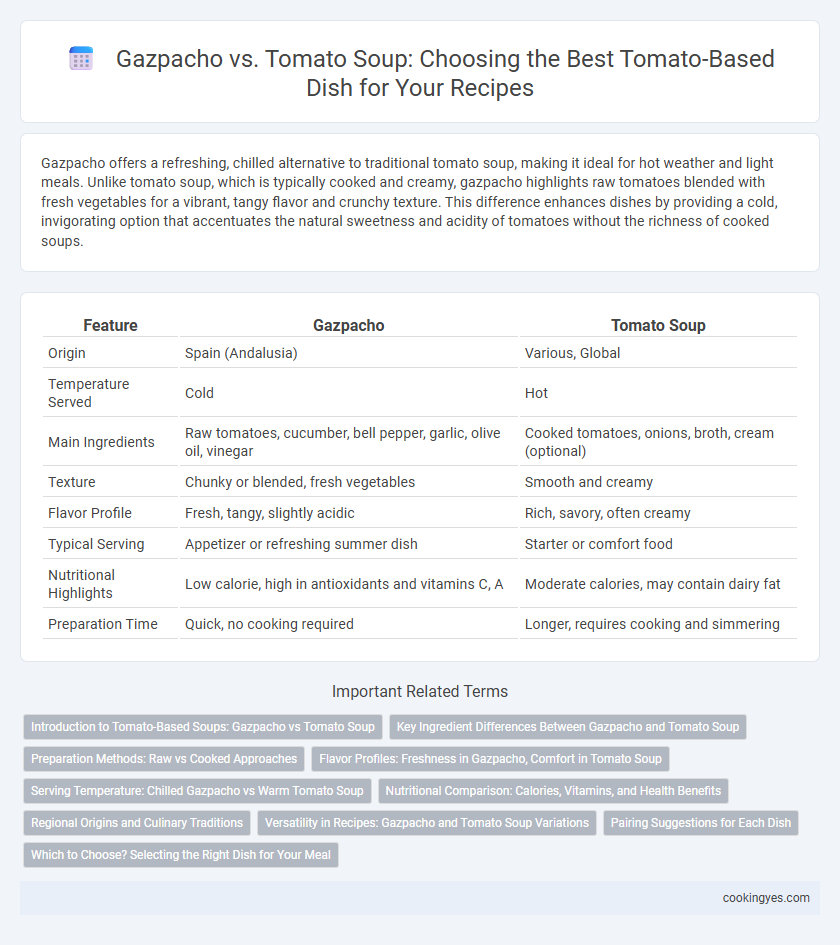Gazpacho offers a refreshing, chilled alternative to traditional tomato soup, making it ideal for hot weather and light meals. Unlike tomato soup, which is typically cooked and creamy, gazpacho highlights raw tomatoes blended with fresh vegetables for a vibrant, tangy flavor and crunchy texture. This difference enhances dishes by providing a cold, invigorating option that accentuates the natural sweetness and acidity of tomatoes without the richness of cooked soups.
Table of Comparison
| Feature | Gazpacho | Tomato Soup |
|---|---|---|
| Origin | Spain (Andalusia) | Various, Global |
| Temperature Served | Cold | Hot |
| Main Ingredients | Raw tomatoes, cucumber, bell pepper, garlic, olive oil, vinegar | Cooked tomatoes, onions, broth, cream (optional) |
| Texture | Chunky or blended, fresh vegetables | Smooth and creamy |
| Flavor Profile | Fresh, tangy, slightly acidic | Rich, savory, often creamy |
| Typical Serving | Appetizer or refreshing summer dish | Starter or comfort food |
| Nutritional Highlights | Low calorie, high in antioxidants and vitamins C, A | Moderate calories, may contain dairy fat |
| Preparation Time | Quick, no cooking required | Longer, requires cooking and simmering |
Introduction to Tomato-Based Soups: Gazpacho vs Tomato Soup
Gazpacho and tomato soup both highlight the rich flavor of tomatoes but differ in preparation and serving temperature. Gazpacho is a cold, refreshing Spanish soup blending raw tomatoes with cucumbers, peppers, and olive oil, ideal for hot weather. In contrast, classic tomato soup is typically served hot and cooked, offering a smooth, comforting option enhanced with herbs and cream.
Key Ingredient Differences Between Gazpacho and Tomato Soup
Gazpacho features raw tomatoes as its key ingredient, blended with fresh vegetables like cucumbers, bell peppers, and onions, creating a cold, refreshing dish ideal for hot weather. Tomato soup relies on cooked tomatoes simmered with broth, herbs, and often cream or butter, resulting in a warm, smooth, and comforting texture. The raw versus cooked tomato base significantly influences the flavor profile and texture, distinguishing gazpacho's vibrant freshness from tomato soup's rich, savory depth.
Preparation Methods: Raw vs Cooked Approaches
Gazpacho, a traditional Spanish cold soup, uses raw tomatoes blended with fresh vegetables like cucumber, bell pepper, and garlic, preserving vibrant flavors and nutrients through a no-cook preparation. Tomato soup, typically simmered and cooked, develops a richer, deeper taste by caramelizing tomatoes and incorporating stock and seasonings during the heating process. The raw approach in gazpacho highlights freshness and crisp textures, while tomato soup's cooked method enhances warmth and a comforting mouthfeel, influencing their respective uses in tomato-based dishes.
Flavor Profiles: Freshness in Gazpacho, Comfort in Tomato Soup
Gazpacho offers a vibrant, chilled flavor profile characterized by fresh ingredients like cucumber, bell peppers, and olive oil, creating a crisp and refreshing experience perfect for warm weather. Tomato soup provides a warm, comforting taste with rich, slow-cooked tomatoes, often enhanced by herbs, cream, or spices, delivering depth and soothing satisfaction. The contrast between gazpacho's bright freshness and tomato soup's hearty warmth highlights their complementary roles in tomato-based dishes.
Serving Temperature: Chilled Gazpacho vs Warm Tomato Soup
Gazpacho is traditionally served chilled, enhancing its refreshing qualities and making it ideal for hot weather, while tomato soup is typically served warm, offering comfort and a rich, hearty flavor. The chilled temperature of gazpacho preserves the crispness of fresh vegetables like cucumbers and bell peppers, contrasting with the smooth, cooked texture of warm tomato soup. Serving temperature significantly influences the dining experience, with gazpacho providing a light, invigorating starter and tomato soup delivering a cozy, savory option.
Nutritional Comparison: Calories, Vitamins, and Health Benefits
Gazpacho contains fewer calories and higher levels of vitamins A and C compared to traditional tomato soup, offering enhanced antioxidant properties. Rich in raw vegetables like cucumber and bell peppers, gazpacho provides additional fiber and essential minerals that support heart health and digestion. Tomato soup, often cooked and cream-based, tends to have more sodium and fat, which can impact cardiovascular health negatively when consumed in excess.
Regional Origins and Culinary Traditions
Gazpacho, originating from Andalusia in southern Spain, is a chilled, raw vegetable soup showcasing fresh tomatoes, cucumbers, and peppers, reflecting Mediterranean culinary traditions focused on light, refreshing flavors. Tomato soup, prevalent in various Western cuisines, notably American and British, is typically served hot and cooked, emphasizing a rich, hearty texture that complements comfort food styles. These regional origins influence their use in tomato-based dishes, with gazpacho favored for cold starters in warm climates and tomato soup preferred in colder regions for warming meals.
Versatility in Recipes: Gazpacho and Tomato Soup Variations
Gazpacho offers a refreshing, cold option with a base of raw tomatoes, cucumbers, and peppers, making it ideal for light summer dishes and raw food recipes. Tomato soup, typically served hot and cooked, provides a rich, comforting flavor that adapts well to creamy, spicy, or chunky variations suitable for colder seasons. Both dishes showcase versatility by incorporating diverse herbs, spices, and complementary ingredients, enhancing tomato-based recipes across different culinary traditions.
Pairing Suggestions for Each Dish
Gazpacho, a chilled Spanish soup made from raw vegetables, pairs excellently with light, fresh dishes like grilled shrimp or avocado salad, enhancing its refreshing and tangy flavors. Tomato soup, typically served hot and cooked, complements heartier meals such as grilled cheese sandwiches or roasted chicken, where its warm, rich profile balances savory ingredients. Both options bring out the best in tomato-based meals but suit different textures and temperature preferences.
Which to Choose? Selecting the Right Dish for Your Meal
Gazpacho offers a refreshing, chilled tomato-based option ideal for hot weather and light meals, whereas tomato soup provides a warm, comforting choice suited for cozy, hearty dishes. The intense, raw flavor of gazpacho highlights fresh vegetables and herbs, perfect as a starter or palate cleanser. Tomato soup's cooked, savory profile pairs well with sandwiches and robust main courses, making each soup selection dependent on meal temperature and desired taste intensity.
Gazpacho vs Tomato Soup for Tomato-based Dishes Infographic

 cookingyes.com
cookingyes.com